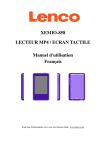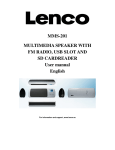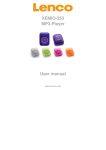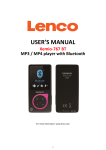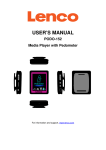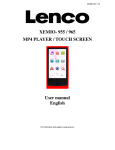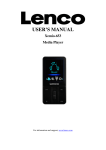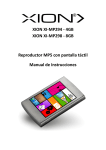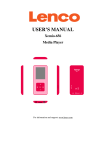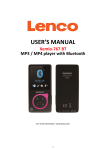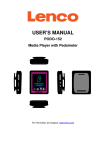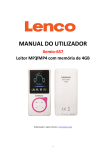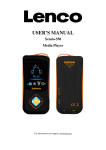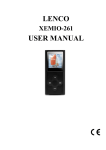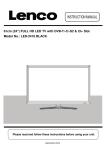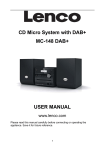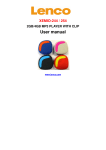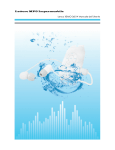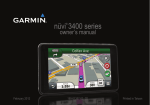Download XEMIO-858 MP4 PLAYER / TOUCH SCREEN User manual
Transcript
XEMIO-858 MP4 PLAYER / TOUCH SCREEN User manual English For information and support, www.lenco.com Warnings Don’ts • Do not place naked flames, such as lighted candles on or near the product. • Do not place objects filled with liquids, such as vases on or near the product. • Do not use or store this product in a place where it is subject to direct sunlight, heat, excessive dust or vibration. • Do not use this product with wet hands. • Do not clean this product with water or other liquids. • Do not block or cover the slots and holes in the product. • Do not push foreign objects into the slots or holes in the product. • Do not attempt to open this product yourself. There are no user serviceable parts inside. • Do not allow children access to plastic bags. SAFETY WARNINGS • Before using this product, read and follow all warnings and instructions. • This product is not intended for use by young children. Young children should be properly supervised. • This product is intended for household use only and not for commercial or industrial use. • Do not expose to dripping or splashing. • No naked flame sources, such as lighted candles, should be placed on the product. • Ventilation should not be impeded by covering ventilation openings with items such as newspapers, table cloths, curtains and the like. • Make sure the unit is adjusted to a stable position. Damage caused by using this product in an unstable position or by failure to follow any other warning or precaution contained within this user manual will not be covered by warranty. Lenco suggests retaining the packaging in case for future transport of the product. If at any time in the future you should need to dispose of this product please note that: All batteries and accumulators need to be removed from this product (Removal of Waste Batteries and Accumulators). WARNING: Prolonged exposure to loud sounds from personal music players may lead to temporary or permanent hearing loss. WARNING: When participating in the traffic listening to a personal music player can make the listener less aware of potential dangers such as approaching cars. 1. Basic controls and interfaces of the player Item Description 2. Item Description 1 ON / OFF Button (Power) 6 Earphone Output Jack (3.5mm Stereo) 2 TFT Display (Touch Function) 7 Memory Card Slot (Micro SD Card) 3 V Button 8 Mini USB Port (PC Connection / Charge) 4 V Button 9 Microphone (mono) 5 Reset (Built-In Tact Switch) Internal Battery The player has an internal battery. When using the unit for the first time, charge it for 3 hours or until the battery icon is show the battery is in full. Note: The player continues to use battery power after it’s been turned to off, if unit isn’t used for a while, the battery might need to be charged. 3. Connection and Charging • Once you have connected player with computer / Power charger, then you will see the “Opening” > “Connect” or “Charging” screen. • In connect screen, the battery is in charging at background. • In charging screen, the bar levels are running in battery icon, the battery is in charging. • The battery icon will show “Full” when the charging is completed. Disconnect it when it is done. Connect Screen Charging Screen Battery Is In Full Important: The battery cannot be charged when your computer is in sleep mode. The USB port on most keyboards does not provide enough power to charge the player. Connect player direct to a USB port on your computer only to prevent charging problem. 4. Connecting and disconnecting the player Connect the player to your computer to upload media files to your player; or to download recorded voice memos to your computer. Connecting the player • Plug the USB cable to the Player’s mini USB port and into a USB port on your computer, then the computer will detect and install the driver automatically. Once the installation is complete the player will be displayed in “My Computer” or for MAC users on the desktop. • Now the player is ready for music files upload / download with your computer. • Transfer the media files by using the computer mouse use drag and place, or copy and paste, in between the player and your computer. Disconnect it when you’re done. Note: The player will disconnect with PC and go into charging mode and/or operation mode, when press once the “ON/OFF” button if in PC connecting mode. Unplug the USB cable and plug it in again to return to PC connection mode if you want. Disconnecting the player • Do not disconnect the player while it’s uploading or downloading files with your computer. • Windows system PC, disconnect the player by clicking the “Safely Remove Hardware” icon in the Windows system tray. • Mac system PC, disconnect the player by dragging the player icon on the desktop to the Trash. • Now it is safe to unplug the USB cable. Note: If you do not “Safely remove hardware” before disconnecting, data can be lost! 5. File Storage Player will create some default folders, in the internal flash memory, when you use it. However, for best result, this is recommended you to put files of different types to store under different directories. For example, music file should be stored under MUSIC dir. Record file stored under RECORD directory. Picture files under PICTURES directory. Video files VIDEO directory. Text files TXT directory. The corresponding application may unable to find the file If it is not saved in this way. 6. Getting Started This player is equipped with a touch screen so you can choose the items or functions by tapping the related icons or files. Turning the player ON and OFF • Press and hold the power “ON/OFF” button, for 3 seconds, to turn the player On and Off. • When the player is turning to On, first the opening screen and then desktop menu will appears to use, the “generating database” message are display at same time. Now the player is ready to use. • Turn OFF the player when you’re not uses it for a longer period. Desktop Menu Every time you turn on the player, you will see the opening screen followed by the desktop menu which contains applications of your player. Tap one of the application icons to open it. Desktop Menu Player Applications Icon caption Description Listen to your songs. Create play list. Listen songs in Artists / Albums / Genre play lists from your music library. Music View your favorite Video / Movie files. Video View your favorite photos and watch them use slide show function. Photo Watch your favorite book. Add tag and pick tag. Selecting favorite page to view. NOTE: This function only supports .txt files. TXT reader Record voice memos with built-in microphone. Playback them on player or save them to your computer. Record Browse all type of supported media files and direct selects your favorite media file to play. Manage to delete those unwanted media files direct from the player. Explorer Listen to the radio stations. Set region, search stations by auto / manual search function, preset / delete stations and FM record. Radio Provides a little bit of fun. Game Adjust player’s setting; Set time, OSD languages, Display light up time and brightness, Set power off mode and more…… Settings General Icon / Button Function In Operation Interface Button / Icon Description Return to upper directory Browse particular application file Return to desktop menu Delete file or file folder Return to previous operation interface or desktop menu V Button Volume up V Button Volume down 7. Music Mode • Tap the “Music” icon; you will now enter the music mode menu as below: Play / Pause / Stop Music file / • To play music, tap • To pause the play, tap • The icon will change into icon and icon will change into icon and it will change into , the music is playing. , the music is pause. after songs playing are finished as per your default setting. Change Next / Previous and Fast-Forward / Fast Backward • Tap icon to play next file. • Tap icon to play previous file. • Tap and hold icon to play fast-forward. • Tap and hold icon to play fast-backward. • Or, drag the playing progress bar to adjust the progress. Change Volume • Press or press and hold / button to increase / decrease volume levels. • Or, direct tag the • For hearing protection; a display warning pop-up on TFT screen, when every time you increase the volume bar to adjust the volume levels. volume level and reach to the default setting level which may exceed 85dB. Tap button to accept the warning and enter into the volume control for increase the level and until to maximum level. Note: The volume control / button are limited to adjust the level at maximum 85dB.. However, to increase volume to above 85dB it can be used the touch control at the Music/Radio interface after accept the warning. . Change Play Mode • Tap / icon to switch to the in-order play / shuffle play. Change EQ Mode • Tap / / / / / / icon to switch the EQ mode. / / / / / icon to switch the repeat mode. Repeat Mode • Tap Note: Icon(s) = Repeat File, = Repeat File Once, = Repeat All Once, = Repeat All, = Intro (10 seconds) Choose Songs in All Music / ID3 List / Play List / Tag List In music mode: • Tap • Tap “All Music” to enter the play list containing all audio files. Then choose a desired file to play. • Tap “ID3 List” > “Artist” to enter the play list sorted by artist. Tab on the artists name to display a icon, a submenu is appears to choose. playlist containing all songs from this artist. Then choose you desired file to play. • Tap “ID3 List” > “Album” to enter the play list sorted by the album name. Tab on the album name to display a playlist containing all songs from this album. Then choose you desired file to play. • Tap “ID3 List” > “Genre” to enter the play list sorted by the genre name. Tab on the genre name to display a playlist containing all songs from this album. Then choose you desired file to play. • Tap “Play List” then choose “My Music List 1 / 2 / 3 / 4 / 5” to enter to your desired play list which you have created and then choose a file to start the play. Those songs in play list will play one by one. • Tap “Tag List”, your tag music / voice file list is appears for choose, and then choose your desired file to play. Note: “All Music” and “ID3 List” functions are works only for music file(s) which have stored at (Main Dir) internal memory. Change / Choose Music Folder (From Flash / Card Memory) icon, a sub-menu is appears to choose. • Tap • Tap “Main Dir / Card Dir”, a list screen appears to use. Choose a folder name which contains music file and choose your desired file to play. If you choose a folder name which have no supported music file, then the list will be show blank. Choose another folder. • And then choose a file you want to play. • Tap icon to back to music mode. Note: “Card Dir” will not show folder and file when the Micro SD card is not installed to player. Add Play List This player allows you to add the current playing music, if you want to put it group together, into the play list. Then you can play this group in next when you choose song(s) by using the tag list function which is mentioned above. icon, a sub-menu is appears to choose. • Tap • Tap “Add List” and then choose “My Music List 1 / 2 / 3 / 4 / 5” where you like them to group. The submenu will disappears and the music is stored into you desired list number. Add Tag List This player also allows you to add tag in the current playing music / voice, if you want to mark the track time, into the tag list. Then you can playback and recall the marked track time of music / voice file(s) in next when you choose song(s) by using the play list function which is mentioned above. • Tap icon, a sub-menu is appears to choose. • Tap “Add Tag”, a “marked” pop up window appears for 1 – 2 seconds. The playing file name with track time is marked and saved into tag list. And now you can add another tag in same song or add tag for other play song if you want. View File Information • Tap icon, an information screen is appears to view, all the information of file will displayed if they have included in file. • Tap icon to back to music mode. Lyric / Artist and Album info Display This player can be display the lyrics at the middle area of the TFT screen if the playing music file is included lyrics information. However, the Artist and Album information will be displayed if no lyrics are available in the playing music. 8. Video Mode Play Video • Tap “Video” icon to enter video mode. Tap “Main Dir / Card Dir” which will appears, when the Micro SD Card is in used. A list screen appears to use. Choose a file to start the play. Or, • Choose a folder name which contains Video file and choose your desired file to play. If you choose a folder name which have no support ed Video file, then the list will be show blank. Choose another folder. • Tap a video file to start the play. Video Mode Interface To Call the Video Tools Menu • Tap any where on the touch screen, the video tools menu will display to use for 3 seconds. • Tap icon to back to file list screen. Use Play / Pause In video tools menu: • To pause the play, tap • To play the video again, tap icon and it will change into , the video is pause. icon and icon will change into , the video is continues to play. Change Next / Previous and Fast-Forward / Fast Backward In video tools menu: • Tap icon to play next file. • Tap icon to play previous file. • Tap and hold icon to play fast-forward. • Tap and hold icon to play fast-backward. • Or, drag the playing progress bar to adjust the progress. Change Volume • Press or press and hold / button to increase / decrease volume levels and the video tools menu also is appear in screen to use for 3 seconds. • You also can direct tag the video tools menu is disappear. volume bar to adjust the volume levels before the In video tools menu: • Tap icon, then direct tag the volume bar to adjust the volume levels before the video tools menu is disappear. • For hearing protection; a display warning pop-up on TFT screen, when every time you increase the volume level and reach to the default setting level which may exceed 85dB. Tap button to accept the warning and enter into the volume control for increase the level and until to maximum level. Change Folder icon, a sub-menu is appears to choose. • Tap • Tap “Main Dir / Card Dir”, a list screen appears to use. Choose a folder name which contains video file and choose your desired file to play. If you choose a folder name which have no supported video file, then the list will be show blank. Choose another folder. Note: “Card Dir” will not show folder and file when the Micro SD card is not installed to player. Add Tag List • Tap icon, a “marked” pop up window appears for 1 – 2 seconds. The playing file name with track time is marked and saved into tag list. And now you can add another tag in same video or add tag for other play video if you want. Play Tag List • Tap icon, a sub-menu is appears to choose. • Tap “Tag List”, your tag video file(s) list is appears for choose, and then choose your desired file to play. 9. Photo Mode • Tap “Photo” icon to enter to photo browse mode. Tap “Main Dir / Card Dir” which will appears, when the Micro SD Card is in used. A list screen appears to use. Choose a file to start the play. Or, • Choose a folder name which contains Photo file and choose your desired file to play. If you choose a folder name which have no supported photo file, then the list will be show blank. Choose another folder. • Tap a file to start the play. • Tap icon to change icon view list to file list view list, this will get the quicker response to list out all photo file by name for choose. • The page will move to different page of submenu, when Micro SD memory card is in used, tap icon to call the list page up if you want. Icon View • File List View Tap and hold on the lower / upper side position in list screen, the list files will move down / up one by one. Chose a desired file to play. To Call the Photo Tools Menu • Tap any where on the touch screen of TFT display, the photo tools menu will display to use for 3 seconds. • icon to back to file list screen. Tap Change Next / Previous photo file In photo tools menu: • In photo browsing mode, tap screen to call up the photo tools menu. • Tap icon to play next file. • Tap icon to play previous file. Use Slide Show and Set Slide Show Time In photo tools menu: • Tap screen to call up the photo tools menu, tap change into • icon. Tap To set slide show time, tap icon to enter to slide show function and the icon will icon to back to manual change mode. icon, a list screen appears and then choose “1s / 2s / 3s / 4s / 5s” you want to use. Move Up / Down List Page • Tap / icon to move the list page down / up. • Or, drag the progress bar to adjust the page down / up, the bar dot will move to the progress bar where you have drag. 10. Txt Reader / eBook Mode • Tap “Txt Reader / eBook” icon to enter the mode. Tap “Main Dir / Card Dir” which will appears, when the Micro SD Card is in used. A list screen appears to use. Choose a file to start the play. Or, • Choose a folder name which contains Text file and choose your desired file to play. If you choose a folder name which have no supported text file, then the list will be show blank. Choose another folder. • Tap a desired file to start Text browsing. File List Text Browsing Change Next / Previous Page • In Text browsing mode. • Tap icon to play next page. • Tap icon to play previous page. • Or, tap at the lower / upper side position, in Text browsing screen, the page will move once down and up. Tap and hold the page will move quickly down / up. Change Folder • Tap icon, a sub-menu is appears to choose. • Tap “Main Dir / Card Dir”, a list screen appears to use. Choose a folder name which contains Text file and choose your desired file to play. If you choose a folder name which have no supported Text file, then the list will be show blank. Choose another folder. • And then choose a file you want to play. • Tap icon to back to text mode. Note: “Card Dir” will not show folder and file when the Micro SD card is not installed to player. Use Skip to Page • Tap icon to show “Skip to” dialogue box, and then selects the skip percentage (0% – 100%) by using the • / icon. Tap outside area of the “Skip to” box to confirm and exit. Then the page is jump to your desired percentage of page. Use Auto Page and Set Auto Page Time • Tap icon to enter to auto page function and the icon will change into icon. Tap icon to back to manual page mode. • To set slide show time, tap icon, a list screen appears and then chooses “10s / 15s / 20s / 25s / 30s” you want to use. Use Save Tag / Pick Tag • Tap icon to show the tag setting box. Tag Setting Box • To save tag, tap any one item of “empty” box, in Save tag, to save the current page into the tag list, and then you will see the page is tag and exist in the list of save tag and pick tag at the same time. • To pick tag, tap any one item in “Pick tag” list as you want, then the saved page will display on screen. • Tap icon to exit from the tag setting box. Or, tap the outside area of the “Save tag” and “Pick tag” box to confirm and exit from the tag setting box. Note: The save tag can be overwritten by the new save tag when all “empty” item is in used. 11. Record Mode • Tap “Record” icon to enter to voice recorder mode. To Recording and Pause Recording • To start recording, tap • To pause the recording, tap icon and it will change into . icon to pause the recording and icon will change into . To Save Record Voice File • Tap icon to save the current recording voice file into memory, the “Saving File…” dialogues box appears for few seconds. The file is saved. To Review and Playback Voice File • Tap icon, a files list appears; all the recorded voice file(s) are show for view. Tap a desired voice file to play if you want it to. Change Record Setting (Quality and Volume) • To change record quality, tap icon, a submenu list appears to choose, and then tap “Qual:”, then choose “High / Medi / Low” you want to use. • To change record volume, tap “Volume:”, then choose “+1 / +2 / +3” you want to use. 12. Use Explorer Menu Explorer function is a file manager; let you know very well that all types of file and folder inside the player, also you can easy manage all types of file, to play or delete them, at those folders • To use explorer function, from desktop menu, tap “Explorer” icon, and then tap “Main Dir / Card Dir” icon, a list screen will appear to choose. • Choose folder(s) and file(s) by tapping the / icon to move the list page down / up. Or, drag the progress bar to adjust the page down / up, the bar dot will move to the progress bar where you have drag. Note: Only “Main Dir” will show to choose, when the Micro SD card is not in used. To Play Media File • Tap any type of media file to play and it will go direct to the necessary mode to open and play the selected file. To Delete Media File / Folder • Choose a media file or folder which you want to delete, then tap icon, a dialogue box appear and then tap “Yes / No” to confirm. Note: The folder, all files in folder, will be deleted once “Yes” is confirmed. 13. Game Mode Player comes with a game named “Mine”. To play game: • Tap “Game” > “Mine” icon, the game screen appear for play • Tap “Easy / Hard” icon to switch the game level. • Tap “Mine” icon to switch to “Sign” mode, and then you can mark the mines with flags, tap it again to return to “Mine”. • Tap • Tap “Exit” icon to back to game menu and then tap icon to re-start for a new game . icon to back to desktop menu. 14. Use Radio • Tap “Radio” icon, a Radio Receiving Screen appears to use. Radio Receiving Screen Set Radio Region: • To change radio region, tap icon, and then tap “CHN / JPN / ERU / USA” you want. Note: • CNH = China, JPN = Japan, ERU = Europe, USA = USA • All stored stations may be deleted when every time the region has set or changed. Tune Station: You can tune the radio stations by using “Auto Search” or “Manual Search”. Auto Search and Save Station: • Tap icon to enter to auto search and auto preset mode. The radio will searching stations in the range of frequency “76 – 92MHz / 87 – 108MHz”, all found radio stations will be stored into “Channel List” table to use. The radio search will stop and show the first received radio station to listening. Manual Search and Save Station: • Tap icon to enter to manual search mode. • To tune your desired radio frequency, tapping or icon to change the frequency Down or Up manually. (0.1MHz by down or up) • Once you desired radio frequency have selected, the station is receiving, by using manual search function, then tap icon to enter save channel mode. A save channel dialog box appears to confirm. • Tap “Ok” to save the receiving channel at “Channel List” table to use. Tap “Cancel” to abort. • Tapping or icon to change the frequency to tune and save another desired radio frequency. Note: Total 20 stations, CH01 – CH20, can be preset in channel list for use. Use Channel List and Change Next Station • Tap icon to show all saved radio frequency channels by “Auto Search” and “Manual Search”. A list screen appears to choose. • To select your desired radio station, tap / progress bar to adjust the page down / up, the icon to move the list page down / up. Or, drag the bar dot will move to the progress bar where you have drag. • Once selected, tap you desired radio channel / frequency, example “CH03 : 90:30 MHz”, to enter the radio station. The selected radio frequency is show and radio station is receiving. • To change another stations, tap icon again or direct tap or icon to change the station(s) down and up according to channel list. To Delete Station • Select the receiving the unwanted station by tapping or icon, and then tap icon, a delete station dialog box appears to confirm. Choose “Ok” confirm the delete or choose “Cancel” to abort. Or, • Tap icon to enter to channel list, and then select the channel station you want to delete, tap icon and choose “Ok” to confirm. Change Volume • Press or press and hold • Or, direct tag the / button to increase / decrease volume levels. volume bar to adjust the volume levels. Mute Radio • To mute the radio, tap • To un-mute, tap icon and it will change into icon and icon will change into , the sound is mute. , the sound is up again. Use FM Record • Select you desired station, tap icon to enter to record mode. Start Recording and Pause Recording • To start recording, tap • To pause the recording, tap icon and it will change into . icon to pause the recording and icon will change into . To Save Record Voice File • Tap icon to save the current recording voice file into memory, the “Saving File…” dialogues box appears for few seconds. The file is saved. To Review and Playback Voice File • Tap icon, a files list appears; all the recorded voice file(s) are show for view. Tap a desired voice file to play if you want it to. Change Record Setting (Quality and Volume) • To change record quality, tap icon, a submenu list appears to choose, and then tap “Qual:”, then choose “High / Medi / Low” you want to use. • To change record volume, tap “Volume:”, then choose “+1 / +2 / +3” you want to use. 15. Use Settings • Tap “Setting” icon to enter to setup interface. Settings Interface Player Information • Tap “Player Information” icon to view relevant read-only product information, such as version, memory and files information…etc. icon to back to setting interface. Note: Tap Set Time • Tap “Set time” to enter date and time setup interface. • Tap • Tap and icon to set those relevant numbers to the current year, month, day and time. icon to back to setting interface and the date and time will be updated at system clock display icon at the top left corner of the screen. Set Language This player can use difference languages. • To set the languages, tap “Language” icon and then choose your desired OSD language. Set Display • Tap “Display” icon to enter to display setup menu. • Tap and icon to choose “0s / 5s / 10s / 15s / 30s / 1m / 5mi / 15m / 30m” for item “Auto lock”. (Key / Screen lock time and Screen dark mode) • The TFT backlight will turn Off, and, the touch screen and all keys control are automatically locked in the selected period of time, if no control is being used, to avoid accidentally key operation. • To unlock, tap anywhere on TFT screen or press once ON/OFF button, the TFT backlight will turn On, and then double tap the “Double Tap To Unlock” icon. However, the auto lock will activates again, if no control is being used, as you selected period of time. Cancel the “Auto lock” function if you want it to. Note: S = second and m = minute • Tap “ to ” icon to choose the backlight bright levels for item “Brightness”. Calibrate In some circumstances, such as electrostatic discharge voltage, you might need to calibrate the touch allocation on screen for the touch function misplaced if happens. • To calibration the touch panel, tap “Calibrate” icon, a calibration marker “ corner on screen, and then touch the center of this “ ” appear on the left top ” to start the calibration. Follow to touch the marker which appears in difference location until calibration is done. Set Power Off • Tap “Power Off” icon > choose “OFF, 10 minutes, 15 minutes, 30 minutes, 60 minutes and 120 minutes” as you desired by tapping the and icon. Note: The setting will change to the default value “OFF” if re-start the player. Default Setting • Tap “Default” icon, the player will prompt “WARNING” about whether to restore system default setting or not. • Tap “Yes” to restore factory default settings. Tap “No” to abandon this restoration. Upgrade You might need to upgrade the firmware for advanced the player performance or firmware getting trouble or damaged in some circumstance, such as electrostatic voltage discharge issue happens. Please follow the instruction posted by the dealer (if any) or follow the instruction from System Utility Tools if provided. It is not recommended to do if the player is proper working. • Tap “Upgrade” icon to enter the firmware upgrade mode, a dialogue box with warning wills popup for action, and then you can insert USB and running the System Utility Tools with new firmware for upgrade with your computer. • Tap “NO” to abort the upgrade action. Reset If the player encounters dead halt during use, press the “RESET” button by using the suitable object / tool, such as wooden tooth pick or plastic screw driver, to restart the player. 16. Use Micro SD Card Slot (T-Flash Card) This player allows you to play those support media files from a micro SD memory card (T-Flash). Insert / Remove the Micro SD card • To safe to insert / remove the micro SD memory card into/from the card slot. Please must turn Off the player. View / play the files on the micro SD Card • From desktop menu, tap “Video / Photo / Text / Explorer” icon, a list screen appears, tap “Main DIR / Card Dir” and then choose your desire folder(s) and media file to play. • For music mode, tap “Music” icon to music mode, and then tap icon, a list screen appears, and then tap “Main DIR / Card Dir” and then choose your desire folder(s) and media file to play. Notes: “Main DIR” is the internal memory of the player. “Card DIR” is the Micro SD Card that you have inserted into the player. 17. Use Video Conversion Tool Video conversion tool is used to convert AV files into advanced AVI or WMV format, recommended video file format, to make them viewable on this player. What Format Files Can Be Converted This tool can converted the video files of the following formats: 1) .AVI format files; 2) .ASF and .WMV Windows Media format files; 3) .MPG, .MPEG and .DAT MPEG1 format files; 4) .RM, .RAM and .RMVB Real Play format files; 5) .MOV Quick Time format files; 6) .VOB MPEG2 format files; 7) .SWF Flash format files (unable to convert into WMV files now); 8) .AVI and .WMV files can be converted into .AVI files again; 9) .AVI and .WMV files can be converted into .WMV files again. Important: For Video Converter, please make sure you have installed Microsoft DirectX 9.0 or above. When to convert Real Media, QuickTime, MPEG2 format video files, please install related DirectShow filter at first. Otherwise, AVI Converter can not work normally. For Media Manager in Windows XP and Windows 2003, please make sure you have installed Microsoft Media Player 10.0 or above, and Microsoft .NET framework 3.0. Software Installation • To install this video conversion tool to your computer, click to open the folder named “Utilities > Video Conversion Software” in provided CD or stored in your Player’ flash memory. • Select “Setup” to start the install program, please follows instructions to click “next” button, and click “close” button when installation is completed successfully. Running the Video Conversion Tool • Click 【start】 button > 【program】 menu, select “Media Player Utilities” > “Video Converter” to enter the main interface. Adding AV files • Click button on the right side of the “Input File” column to add AV files to be converted, and a dialogue box will automatically pop out for adding one or more AV files. • After the file is added, the path of the AV file will be displayed in the “Input File” field as shown below; and, relevant information of the added file, such as the check box, file name and path, status and file length, will be displayed in the status column. Input and Output AV file • Click button to choose the folder where to save the converted AV files, the “browse file folder” dialogue box will pop up, select the specified storage path and then click “confirm” button to complete. • Click button to select the folder where the original files are, a dialogue box will pop up for adding one or more AV files, the original file will show in the file window once selected. • Select with highlight the unprocessed AV files in the file window, the icon will be highlighted into . And then click icon and a dialog box will be shown. • Choosing pixels of AVI (Xvid) / WMV to “320x240” . • Frames per second to “Middle / High” • Frame Ratio to “Full Screen” • Click OK to confirm. • Click • After conversion, the converted AV files will play automatically for preview. • And now the converted AV file is ready to transfer, you can simply copy and place those converted AVI to start converting. files to the media player. Note: Only pixels in 320x240 can be supported, make sure 320x240 is selected. 18. Troubleshooting Play cannot turn ON Check battery is it charged with enough energy. No sound is heard from headphone. Check whether Volume is set “0” and connect the headphone plugs firmly. Check whether the headphone plug is dirty. Corrupted MP3 may make a static noise and the sound may cut off. Make sure that the music files are not corrupted. Key or touch function does not work Check whether key lock switch is in locked position. Characters in LCD are corrupted Check whether the right language has been selected. Download of music files fails. Check whether USB cable is damaged and is connected properly. Check whether driver is installed correctly. Check whether the player’s memory is in full. 19. Specifications Display 2.4 inches TFT, Resolution 320x240(RGB) Dimension 86.2mm (H) x 52.5mm (W) x 9.5mm (D) Weight 52g PC Connection USB 2.0 (High Speed) Earphone Impedance 32 Ohm External Memory Micro SD Memory Card; T-Flash (up to 8GB) Rechargeable Battery Lithium: 3.7V, 400mAh Music playing time: > 7 hours (power save mode, 2/3 earphone output) Video playing time: > 2 hours Voice Recording format Music Format Video Format WAV 32kbps / 64kbps / 192kbps MP3, WMA 32kbps - 320kbps APE, FLAC, OGG AVI(Xvid), WMV, FLV, 3GP, QVGA resolution 320x240, 30fps (max) RM/RMVB, Radio FM Photo Format JPEG, BMP, GIF, TIF, PNG TXT Format TXT Audio Earphone Output Power L: 275mVrms + R: 275mVrms (at 32Ohm) Frequency response 20Hz – 20,000Hz SNR > 70dB ℃ - 40℃ 76 – 90MHz, 87 – 108MHz Operation Temperature 0 OSD Languages Multi Languages Operation Systems Windows 2000 / XP / Vista/ Win7, Mac OS 9.2 or above 20. DISCLAIMER Updates to Firmware and/or hardware components are made regularly. Therefore some of the instruction, specifications and pictures in this documentation may differ slightly from your particular situation. All items described in this guide for illustration purposes only and may not apply to particular situation. No legal right or entitlements may be obtained from the description made in this manual 21. SERVICE AND SUPPORT For information: www.lenco.com For support: http://lencosupport.zendesk.com Lenco helpdesk: Germany 0900-1520530 (Local charges) The Netherlands 0900-23553626 (Local charges + 1ct p/min) Belgium 02-6200115 (Local charges) France 03-81484280 (Local charges) The helpdesk is accessible from Monday till Friday from 9 AM till 6 PM. When contacting Lenco, you will always be asked for the model and serial number of your product. The serial number can be found on the back of the device. Please write down the serial number below: Model: XEMIO-858 Serial number:_________________________________ Lenco offers service and warranty in accordance to European law, which means that in case of repairs (both during and after the warranty period) you should contact your local dealer. Important note: It is not possible to send products that need repairs to Lenco directly. Important note: If this unit is opened or accessed by a non-official service center in any way, the warranty expires. This device is not suitable for professional use. In case of professional use, all warranty obligations of the manufacturer will be voided. 22. RECYCLING This symbol indicates that the relevant electrical product or battery should not be disposed of as general household waste in Europe. To ensure the correct waste treatment of the product and battery, please dispose them in accordance to any applicable local laws of requirement for disposal of electrical equipment or batteries. In so doing, you will help to conserve natural resources and improve standards of environmental protection in treatment and disposal of electrical waste (Waste Electrical and Electronic Equipment Directive). 23. CE Products with the CE marking comply with the EMC Directive (2004/108/EC) and the Low Voltage Directive (2006/95/EC) issued by the Commission of the European Community The declaration of conformity may be consulted at http://www.lenco.eu/supportfiles/CE/mnkjacoshf8d.pdf ®All rights reserved

























